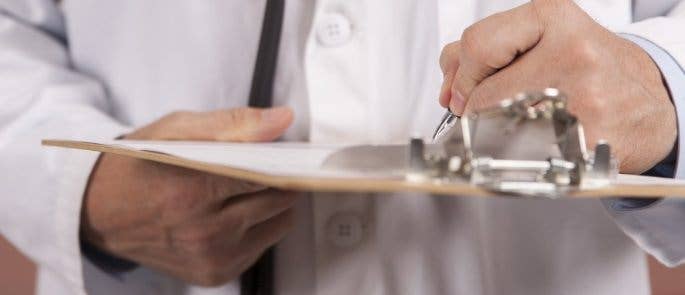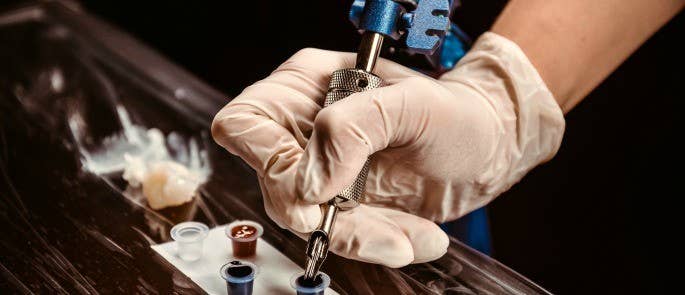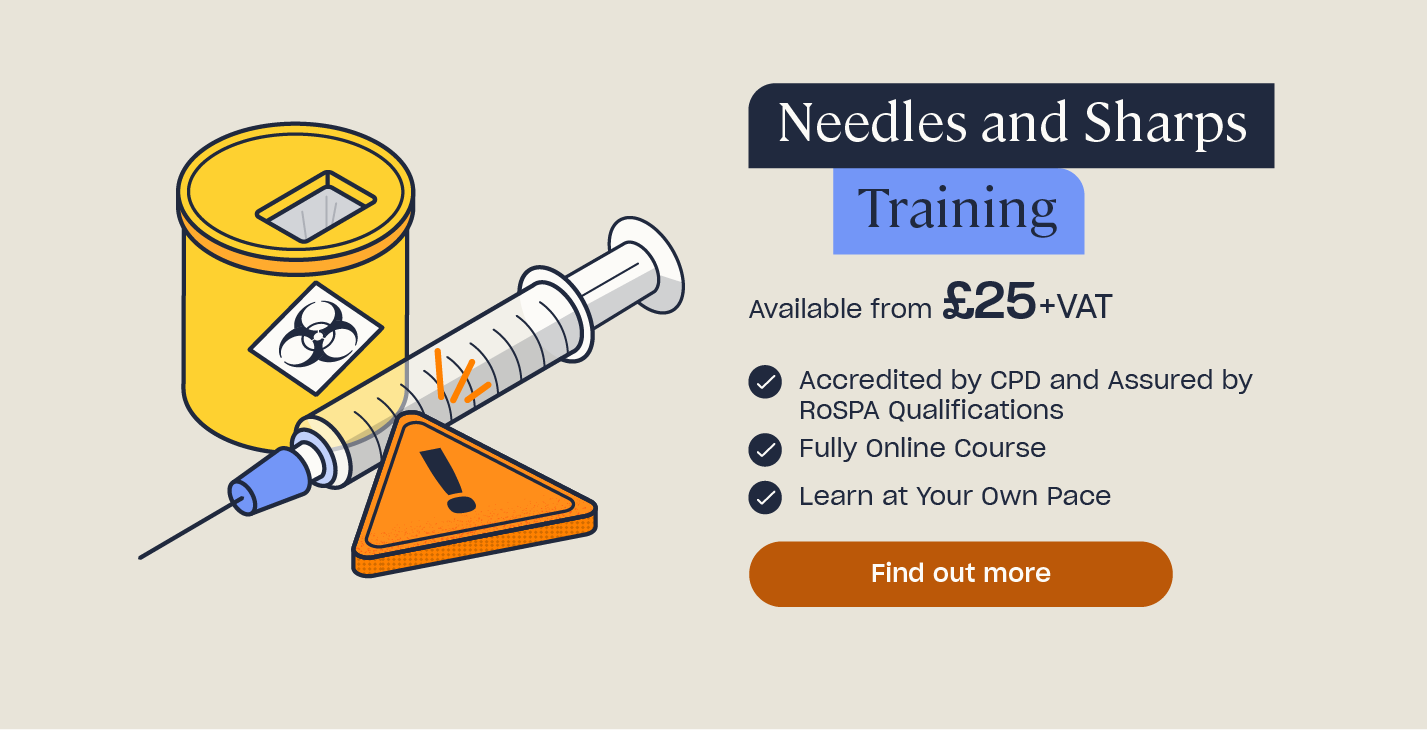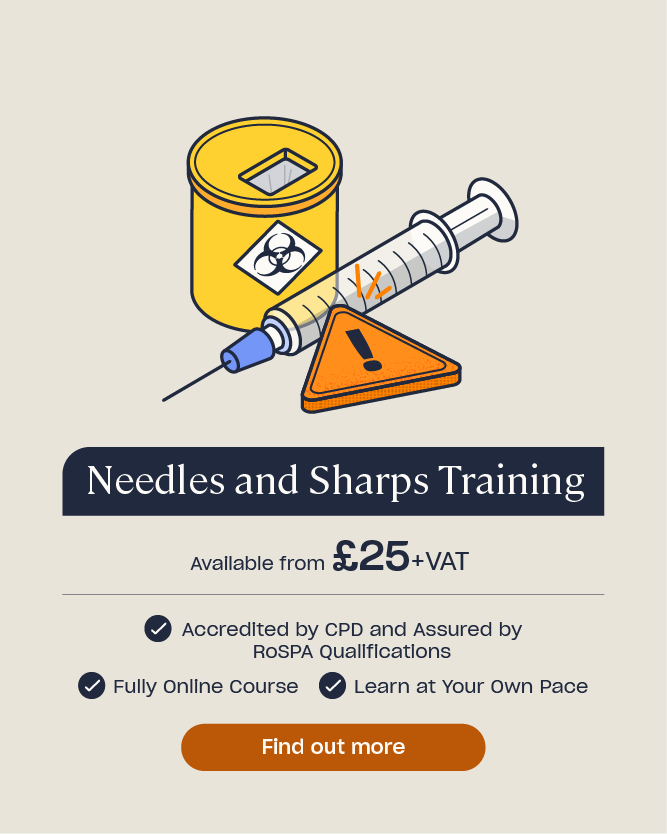Sharps & Needlestick Risk Assessment Template
Around 100,000 needlestick injuries are reported every year in the UK. A needlestick or sharps injury could have severe mental and health consequences. Therefore, it’s vital that you take appropriate actions to eliminate or reduce the risk of an injury. To help achieve this, you must carry out a sharps risk assessment.
This article will outline the steps involved in a sharps risk assessment and provide you with a template so you can effectively carry out a risk assessment for your establishment.

What are Sharps?
A sharp is any item that could result in a cut or puncture wound to an individual. This includes:
- Needles and hypodermic needles.
- Syringes.
- Scalpels.
- Blades, including knives and saws.
- Infusion sets used for insulin delivery.
- Broken glass.
A sharps injury occurs when a sharps object penetrates the skin. There are several risks associated with sharps injuries, and an accidental puncture could have serious mental and physical repercussions.
The risks associated with a sharps injury include:
- Exposure to blood-borne viruses (BBV’s) and other pathogens. This includes HIV, hepatitis B (HBV) and hepatitis C (HCV). Even very small amounts of bodily fluids on a sharp can transmit diseases.
- Psychological stress. The period of testing after exposure to bodily fluids from a sharps injury can be very stressful. This stress can last for several months and can seriously impact the lives of the injured individual and their family.
- Financial repercussions. Your business could face serious financial repercussions after an injury, including lost working time, investigation costs and re-hiring costs.
Sharps Regulations
There are several pieces of legislation that cover the safe use and disposal of sharps instruments in the UK. To comply with the law, a competent person must carry out a sharps risk assessment, identifying hazards and risks and deciding on controls.
This person might be you, or it might be another nominated person, but it’s important that appropriate risk assessments are carried out for your establishment.
Need a Course?
Our Needles & Sharps Training outlines the best practice guidelines for the safe use and disposal of sharps equipment and details key sharps-related legislation to ensure both employers and employees are aware of their legal responsibilities regarding the safe use of sharps.
Sharps Risk Assessment
There are 5 steps to a sharps risk assessment, these are:
- Identify the hazards.
- Decide who might be harmed and how.
- Evaluate the risks and decide on precautions.
- Record your findings and implement them.
- Monitor performance and review.
Step 1 – Identify the hazards
You should start your risk assessment by identifying all potential hazards in the workplace. When working with needles and sharps, your employees will be exposed to blood-borne viruses such as hepatitis B and C and HIV. A sharp-related injury always carries the risk of a blood-borne virus.
Additionally, you must also consider other hazards, including the stress and anxiety that could result from having blood tests and treatment after an incident.
Some sharps devices will carry a higher risk of transmitting a disease, for example:
- Needles, especially hollow bore needles.
- IV cannulae.
- Winged steel needles, also known as butterfly needles.
- Phlebotomy needles.
You will need to consider this elevated risk when you complete your risk assessment. A competent person will survey your workplace and identify all hazards.

Step 2 – Decide who might be harmed and how
Employees who regularly work with sharps are most at risk of a sharps-related injury. This includes:
- Nurses.
- Phlebotomists.
- Doctors.
- Laboratory technicians.
- Tattooists.
Remember that sharps legislation covers both directly employed staff members and some self-employed workers, including contract and agency workers. Therefore, ensure you consider these workers during your risk assessment.
Though they do not regularly use sharps, cleaning staff are also at a high risk of injury if sharps are not disposed of correctly.

Step 3 – Evaluate the risks and decide on precautions
You should make all reasonable effort to remove or reduce the possibility of exposure to the hazards you have identified. The best possible way to prevent an injury is to eliminate the risk.
To do this, you should:
- Eliminate all unnecessary injections.
- Eliminate the use of unnecessary sharps.
- Substitute sharps for equipment that doesn’t involve sharps use.
If you cannot completely eliminate the hazards, you should take all necessary actions to reduce and control the risks. For example, you should:
- Immunise your employees against hepatitis B.
- Train your employees on the risks, as well as the proper use and disposal of sharps equipment.
- Ensure appropriate sharps bins are in place.
- Enforce the use of appropriate PPE, where necessary.
- Introduce safer sharps, with protective features, where possible and remove all unsafe sharps from use.
- Have a needlestick injury prevention committee.

Step 4 – Record your findings and implement them
You should document all the information from your risk assessment, including the control methods you have decided on, and use this as an action plan to reduce the risk of an injury.
Depending on the size of the organisation, you might need to carry out more than one risk assessment, i.e. one per floor or ward.
You should share the results of your risk assessment with all the employees you have identified as ‘at risk’.
Step 5 – Monitor performance and review
Periodically review and update your risk assessment to ensure that it remains up to date and effective. You should use accident reports to identify areas you missed during your risk assessment and use the information to update your controls.
Sharps Risk Assessment Template
Risk assessments are important. They ensure that you eliminate or reduce the risks to your employees and effectively control workplace hazards. Use our downloadable sharps risk assessment template to help you properly carry out and document your risk assessment, so you can protect your staff and comply with your legal duties.
Further Resources:
- Needles & Sharps Awareness Training
- What Methods can be used for the Disposal of Infectious Waste?
- 5 Simple Tips for Preventing Infection
- Personal Protective Equipment (PPE) in Healthcare Quiz
- Needles and Sharps Quiz
- What Are the Different Types of Healthcare Waste and Why Are They Important?







